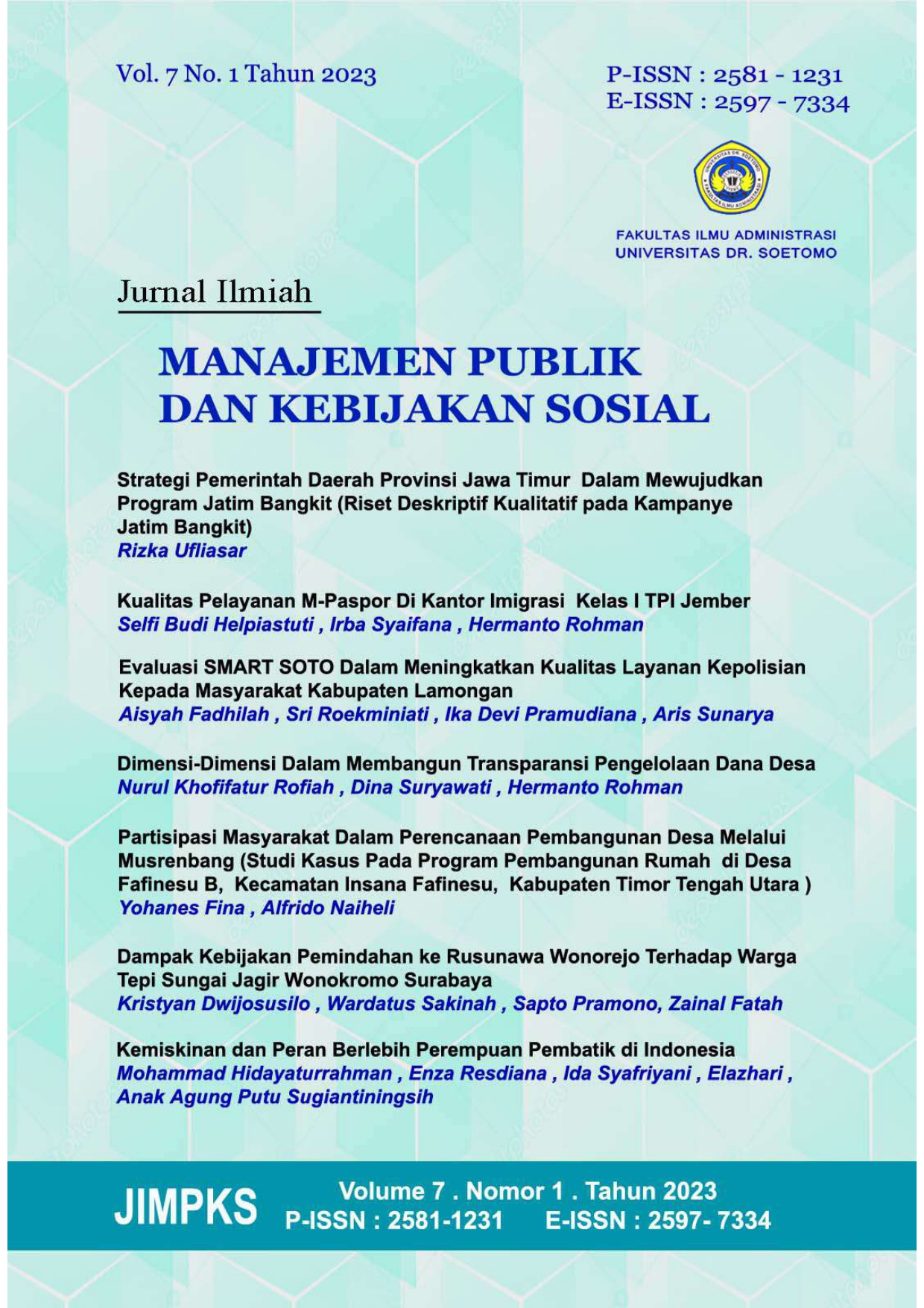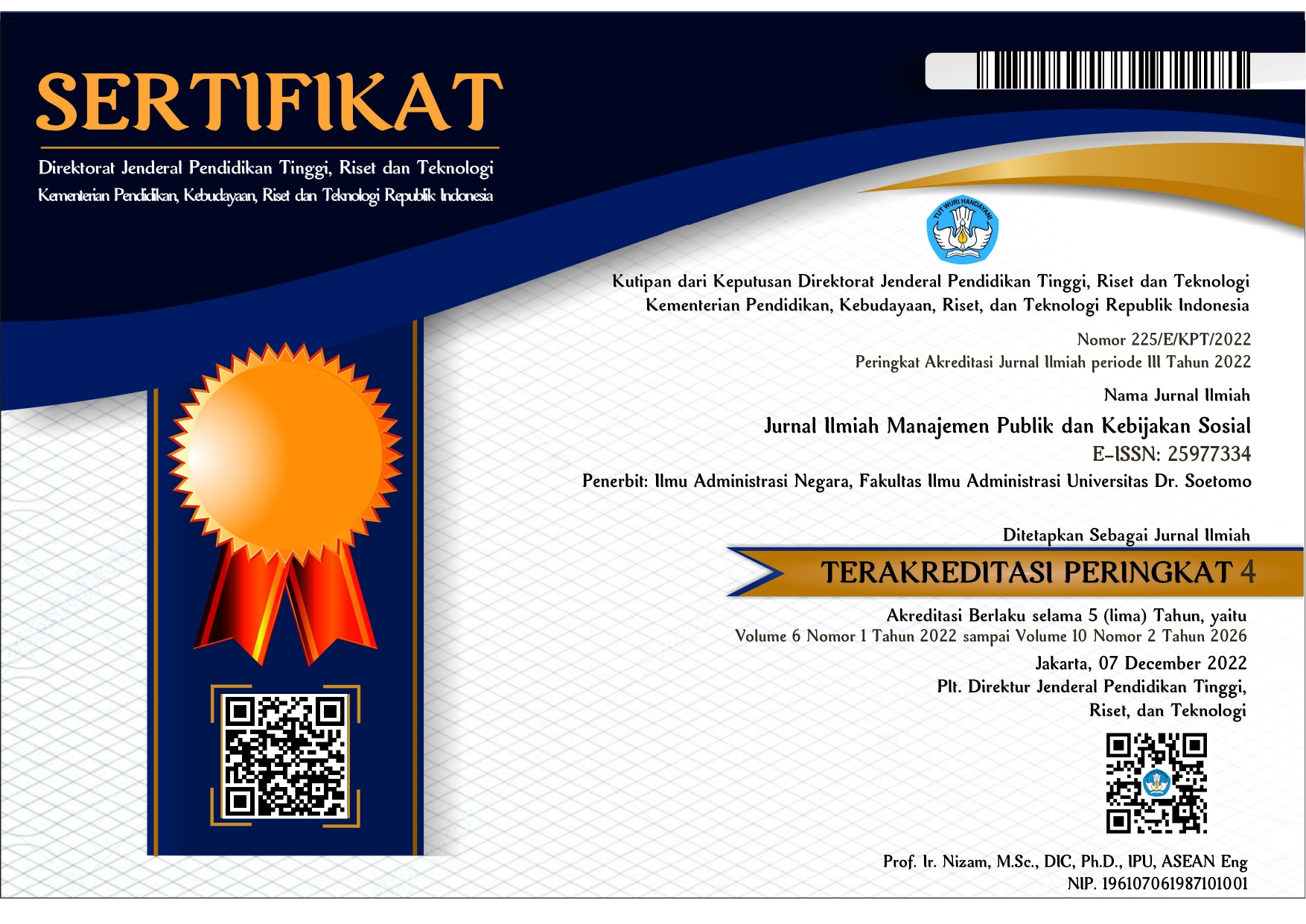Kemiskinan Dan Peran Berlebih Perempuan Pembatik Di Indonesia
 Abstract views: 735
,
Abstract views: 735
,
 PDF (Bahasa Indonesia) downloads: 463
PDF (Bahasa Indonesia) downloads: 463
Abstract
Sebagai negara yang masuk kategori berkembang, jumlah penduduk miskin di Indonesia masih terbilang tinggi. Penduduk miskin di Indonesia juga terdiri dari perempuan. Perempuan miskin di Indonesia memiliki kerentanan terhadap berbagai persoalan ekonomi. Penelitian ini dilakukan untuk mengungkap dan menganalisis, bagaimana para perempuan di Indonesia yang berada di dalam kondisi miskin melakukan peran berlebih. Analisis dilakukan dengan menggunakan teori peran. Penelitian ini menggunakan metode kualitatif. Pengumpulan data dilakukan melalui wawancara mendalam dengan berbagai informan. Selain itu dilakukan juga pengamatan langsung terhadap kegiatan membatik yang dilakukan perempuan di beberapa wilayah di Indonesia. Penelusuran dokumen juga dilakukan terhadap data dan sumber yang relevan. Hasil penelitian menunjukkan bahwa perempuan pembatik di Indonesia yang dalam kondisi miskin berusaha memperbaiki kualitas hidup dengan peran berlebih. Mereka tidak hanya menjadi ibu rumah tangga, tapi juga bekerja mencari nafkah dengan bekerja pada beberapa bidang seperti menjadi petani dan menjadi membatik. Pendapatan dari dua atau tiga pekerjaan belum menjadikan perempuan di Indonesia keluar dari kemiskinan. Salah satu faktor yang menjadi penyebabnya adalah pendapatan dari membatik terbilang rendah, belum mencapai taraf layak. Pendapatan yang masih rendah dan belum layak yang diperoleh perempuan tersebut, tidak hanya digunakan untuk memenuhi kebutuhan diri sendiri, namun juga untuk kebutuhan keluarga termasuk suami dan anak. Sehingga perempuan tetap berada dalam kondisi miskin.
References
Aggarwal, S. (2018). Do rural roads create pathways out of poverty? Evidence from India. Journal of Development Economics, 133, 375–395. https://doi.org/10.1016/j.jdeveco.2018.01.004
Aisyah, N. (2013). Relasi Gender Dalam Institusi Keluarga Dalam Pandangan Teori Sosial Dan Feminis. Muwazah, 5(2), 203–224.
Arifin, Samsul. (2018). Bupati Pamekasan Minta Pemerintah Pusat Promosikan Batik Madura.http://m.beritajatim.com/gaya_hidup/345690/bupati_pamekasan_minta_pemerintah_pusat_promosikan_batik_madura.html
Beck, T. (1989). Survival Strategies and Power amongst the Poorest in a West Bengal Village. IDS Bulletin, 20(2), 23–32. https://doi.org/10.1111/j.1759-5436.1989.mp20002004.x
Birch, J., Rishbeth, C., & Payne, S. R. (2020). Nature doesn’t judge you – how urban nature supports young people’s mental health and wellbeing in a diverse UK city. Health and Place, October 2019, 102296. https://doi.org/10.1016/j.healthplace.2020.102296
Bohren, M. A., Mehrtash, H., Fawole, B., Maung, T. M., Balde, M. D., Maya, E., Thwin, S. S., Aderoba, A. K., Vogel, J. P., Irinyenikan, T. A., Adeyanju, A. O., Mon, N. O., Adu-Bonsaffoh, K., Landoulsi, S., Guure, C., Adanu, R., Diallo, B. A., Gülmezoglu, A. M., Soumah, A. M., … Tunçalp, Ö. (2019). How women are treated during facility-based childbirth in four countries: a cross-sectional study with labour observations and community-based surveys. The Lancet, 394(10210), 1750–1763. https://doi.org/10.1016/S0140-6736(19)31992-0
Booth, A. (1993). Counting the poor in indonesia. In Bulletin of Indonesian Economic Studies (Vol. 29, Issue 1). https://doi.org/10.1080/00074919312331336341
Campos, Villani, Davis, & Takagi. (2014). Ending Extreme Poverty. In The World Bank. http://www.worldbank.org/en/publication/global-monitoring-report/report-card/twin-goals/ending-extreme-poverty
Chauvin, J. P., Glaeser, E., Ma, Y., & Tobio, K. (2017). What is different about urbanization in rich and poor countries? Cities in Brazil, China, India and the United States. Journal of Urban Economics, 98, 17–49. https://doi.org/10.1016/j.jue.2016.05.003
Christiaensen, L., & Kanbur, R. (2018). Secondary towns, jobs and poverty reduction: Introduction to World development special symposium. World Development, 108, 219–220. https://doi.org/10.1016/j.worlddev.2018.04.010
CNNIndonesia. (2020).Papua Masih Jadi Provinsi dengan Angka Kemiskinan Tertinggi. https://www.cnnindonesia.com/ekonomi/20200115174641-532-465658/papua-masih-adi-provinsi-dengan-angka-kemiskinan-tertinggi
Creswell, John. W. (2016). “Research Design. Pendekatan Metode Kualitatif, Kuantitatif, dan Campuran. Edisi keempat.”. Yogyakarta: Pustaka Pelajar
Dewi, S., Abd Majid, M. S., Aliasuddin, & Kassim, S. (2018). Dynamics of Financial Development, Economic Growth, and Poverty Alleviation: The Indonesian Experience. South East European Journal of Economics and Business, 13(1), 17–30. https://doi.org/10.2478/jeb-2018-0002
Fatwa Apriliani, M. (2018). Economic Education Analysis Journal PENGARUH KARAKTERISTIK WIRAUSAHA, MODAL USAHA DAN TENAGA KERJA TERHADAP KEBERHASILAN UMKM BATIK Info Artikel. 7(2), 761–776. http://journal.unnes.ac.id/sju/index.php/eeaj
Fosu, A. K. (2017). Growth, inequality, and poverty reduction in developing countries: Recent global evidence. Research in Economics, 71(2), 306–336. https://doi.org/10.1016/j.rie.2016.05.005
Gibson, H. J., & Pennington-Gray, L. (2005). Insights from Role Theory: Understanding Golf Tourism . European Sport Management Quarterly, 5(4), 443–468. https://doi.org/10.1080/16184740500430330
Guiga, H., & Rejeb, J. Ben. (2012). Poverty, growth and inequality in developing countries. International Journal of Economics and Financial Issues, 2(4), 470–479.
Halim, R. E. (2017). The impact of trust-distrust toward quality of life: The case of poor and non-poor household in Indonesia. European Research Studies Journal, 20(3), 801–819.
Han, B., Kim, J., & Timmermans, H. (2019). Task allocation and gender roles in dual earner households: The issue of escorting children. Travel Behaviour and Society, 14(March 2018), 11–20. https://doi.org/10.1016/j.tbs.2018.09.001
Hannah. (2013). Membangun dan Mengembangkan Ekonomi Mikro Melalui Batik Tulis (Studi Kasus Pemberdayaan Kelompok Perempuan Pembatik Tulis Desa Ramasari Cianjur Jawa Barat). Journal of Chemical Information and Modeling, 53(9), 1689–1699. https://doi.org/10.1017/CBO9781107415324.004
Hematang, Y. I. P., Setyowati, E., & Hardiman, G. (2014). Indonesian Journal of Conservation. Indonesian Journal of Conservation, 3(1), 99–110. https://journal.unnes.ac.id/nju/index.php/ijc/article/view/3085
Hemphill, L. (2008). Social Role Theory as a Means of Differentiating Between First-Generation and Nonfirst-Generation College Students. In Dissertation. KANSAS STATE UNIVERSITY.
Heslop, P., Davey Smith, G., Macleod, J., & Hart, C. (2001). The socioeconomic position of employed women, risk factors and mortality. Social Science and Medicine, 53(4), 477–485. https://doi.org/10.1016/S0277-9536(00)00350-6
Ismail, T., Wiyantoro, L. S., Meutia, & Muchlish, M. (2012). Strategy, Interactive Control System and National Culture: A Case Study of Batik Industry in Indonesia. Procedia - Social and Behavioral Sciences, 65(ICIBSoS), 33–38. https://doi.org/10.1016/j.sbspro.2012.11.087
Karima, H. (2010). Pola wilayah Industri Batik di Pekalongan.
Kristanti. (2017). TERHADAP KEPUTUSAN TENAGA KERJA MUDA UNTUK BEKERJA PADA INDUSTRI KECIL MENENGAH ( IKM ) BATIK Disusun Oleh :
Leone, T. (2019). Women’s mid-life health in Low and Middle Income Countries: A comparative analysis of the timing and speed of health deterioration in six countries. SSM - Population Health, 7(October 2018), 100341. https://doi.org/10.1016/j.ssmph.2018.100341
Mahembe, E., & Odhiambo, N. M. (2018). The Dynamics of Extreme Poverty in Developing Countries. Studia Universitatis „Vasile Goldis” Arad – Economics Series, 28(2), 18–35. https://doi.org/10.2478/sues-2018-0007
Margried, N. (2015). Batik Fractal Community: Creative Engagement through Technology. Procedia - Social and Behavioral Sciences, 184(August 2014), 214–222. https://doi.org/10.1016/j.sbspro.2015.05.082
Neil, F., & Umar, S. (2016). The World Bank’s Classification of Countries by Income. World Bank, January.
Newton, C. R., & Garcia, H. H. (2012). Epilepsy in poor regions of the world. The Lancet, 380(9848), 1193–1201. https://doi.org/10.1016/S0140-6736(12)61381-6
Nurhaida, I., Noviyanto, A., Manurung, R., & Arymurthy, A. M. (2015). Automatic Indonesian’s Batik Pattern Recognition Using SIFT Approach. Procedia Computer Science, 59(Iccsci), 567–576. https://doi.org/10.1016/j.procs.2015.07.547
Nurhamida, Y. (2013). Power in marriage pada ibu bekerja dan ibu rumah tangga. Journal Psikogenesis, 1(2), 185–198. http://academicjournal.yarsi.ac.id/index.php/Jurnal-Online-Psikogenesis/article/view/45/pdf
Parsons, T. (1974). Social Organization: A General Systems and Role Theory Perspective By Alvin L. Bertrand. Social Forces, 53(1), 126–127.
Pertiwi, A. (2015). ANALISIS GENDER BURUH BATIK DALAM UKM “ BATIK PESISIR ” DESA KEMPLONG KECAMATAN WIRADESA.
Rahmawati, R., Rismawati, S. D., & Zaduqisty, E. (2013). Sistem pengupahan dan pembagian kerja perempuan buruh batik berbasis putting out system di kota pekalongan (The wage system and the division of labor of women Batik worker based on putting out system in Pekalongan). Research Journal, 10(2), 274–293.
Ramadhani, N. (2016). Implikasi Peran Ganda Perempuan Dalam Kehidupan Keluarga Dan Lingkungan Masyarakat. Sosietas, 6(2). https://doi.org/10.17509/sosietas.v6i2.4245
Rangkuti, A. H., Rasjid, Z. E., & Santoso, D. J. (2015). Batik Image Classification Using Treeval and Treefit as Decision Tree Function in Optimizing Content Based Batik Image Retrieval. Procedia Computer Science, 59(Iccsci), 577–583. https://doi.org/10.1016/j.procs.2015.07.551
Rizal, M. F., & van Doorslaer, E. (2019). Explaining the fall of socioeconomic inequality in childhood stunting in Indonesia. SSM - Population Health, 9, 100469. https://doi.org/10.1016/j.ssmph.2019.100469
Robles Aguilar, G., & Sumner, A. (2020). Who are the world’s poor? A new profile of global multidimensional poverty. World Development, 126, 104716. https://doi.org/10.1016/j.worlddev.2019.104716
Scoot, J. (1998). Seeing Like a State. In J. Scott (Ed.), Yale University Press. Yale University Press.
Setyaningrum, C. T. S., Fitri, E., Rachmad, F., Nugraha, D., Nathanael, V., & Anindia, R. (2019). Neuromuscular disorders in Batik workers at Yogyakarta Indonesia. Journal of the Neurological Sciences, 405, 265. https://doi.org/10.1016/j.jns.2019.10.1307
Shirley, M. (2013). Why are Poor Countries Poor? Institutions and Development, October 2002. https://doi.org/10.4337/9781848443990.00010
Sinclair, K., Ahmadigheidari, D., Dallmann, D., Miller, M., & Melgar-Quiñonez, H. (2019). Rural women: Most likely to experience food insecurity and poor health in low- and middle-income countries. Global Food Security, 23(August 2018), 104–115. https://doi.org/10.1016/j.gfs.2019.04.006
Soekanto, S. (1982). Sosiologi suatu pengantar. In Rajawali.
Štulhofer, A., Kuljanić, K., & Buzina, D. Š. (2011). Sexual health difficulties in a population-based sample of croatian women aged 18-35 and the effects of the dual (Career and Motherhood) role. Journal of Sexual Medicine, 8(5), 1314–1321. https://doi.org/10.1111/j.1743-6109.2010.02100.x
Sugiyono. (2011). Metode Penelitian Kuantitatif, Kualitatif dan R&D. Bandung: Afabeta
Sutisna, S., Wibowo, E., Rokhmat, M., Rahman, D. Y., Murniati, R., Khairurrijal, K., & Abdullah, M. (2017). Batik Wastewater Treatment Using TiO2 Nanoparticles Coated on the Surface of Plastic Sheet. Procedia Engineering, 170, 78–83. https://doi.org/10.1016/j.proeng.2017.03.015
Tumbage, S. M. ., Tasik C.M, F., & Tumengkol, S. M. (2017). Peran Ganda Ibu Rumah Tangga Dalam Meningkatkan Kesejahteraan Keluarga Di Desa Allude Kecamatan Kolongan Kabupaten Talaud. Acta Diurna, VI(2), 2.
USAID. (2012). List of Advanced Developing Countries A Mandatory Reference for ADS Chapter 310. 2.
Valent, P. (1998). Introduction to survival strategies. From Survival to Fullfillment: A Framework for the Life-Trauma Dialectic, 115–123.
Victora, C. G., Barros, A. J. D., França, G. V. A., da Silva, I. C. M., Carvajal-Velez, L., &Amouzou, A. (2017). The contribution of poor and rural populations to national trends in reproductive, maternal, newborn, and child health coverage: analyses of cross-sectional surveys from 64 countries. The Lancet Global Health, 5(4), e402–e407. https://doi.org/10.1016/S2214-109X(17)30077-3
Vidyasagar, D. (2006). Global notes: Counting the world’s poor - How do we define poverty? Journal of Perinatology, 26(6), 325–327. https://doi.org/10.1038/sj.jp.7211531
Wibawa, & Wihartanti. (2019). STRATEGI PEREMPUAN KEPALA KELUARGA (PEKKA) DALAM MENCIPTAKAN KEMANDIRIAN EKONOMI KELUARGA DI DESA GESI KECAMATAN GESI KABUPATEN SRAGEN. 6(2), 1–9. http://ojs.fkip.ummetro.ac.id/index.php/ekonomi/article/view/1691
Widiaty, I., Riza, L. S., Danuwijaya, A. A., Hurriyati, R., & Mubaroq, S. R. (2017). Mobile-based augmented reality for learning 3-dimensional spatial Batik-based objects. Journal of Engineering Science and Technology, 12(Special Issue 10), 12–22.
Witro, D. (2019). Kelompok Wanita Tani (Kwt) Pelangi Kopi Sebagai Inovasi Pemberdayaan Janda Guna Mengentaskan Kemiskinan Di Desa Giri Mulyo. Komunitas, 10(2), 93–106. https://doi.org/10.20414/komunitas.v10i2.1666
World Bank. (2010). The State of the Poor: Where are the Poor and where are they Poorest? Poverty Reduction and Equity, 2010(figure 1), 2–5. https://www.worldbank.org/content/dam/Worldbank/document/State_of_the_poor_paper_April17.pdf%0Ahttp://www.worldbank.org/content/dam/Worldbank/document/State_of_the_poor_paper_April17.pdf
Yusrina, A., Budiyati, S., & Yumna, A. (2011). AKSES TERHADAP KEADILAN : PEMBERDAYAAN PEREMPUAN KEPALA KELUARGA DI INDONESIA Studi Kasus di Provinsi Nanggroe Aceh Darussalam , Jawa Barat , Kalimantan Barat , dan Nusa Tenggara Timur.
Zulminarni, N., & PEKKA. (2014). Menguak Keberadaan dan Kehidupan Perempuan Kepala keluarga.
Copyright (c) 2023 Mohammad Hidayaturrahman, Enza Resdiana, Ida Syafriyani, Elazhari Elazhari, Anak Agung Putu Sugiantiningsih

This work is licensed under a Creative Commons Attribution-ShareAlike 4.0 International License.
Authors who publish with JIMPKS: Jurnal Ilmiah Manajemen Publik dan Kebijakan Sosial agree to the following terms:
-
Authors retain copyright and grant the journal right of first publication with the work simultaneously licensed under a Creative Commons Attribution License (CC BY-SA 4.0) that allows others to share the work with an acknowledgment of the work's authorship and initial publication in this journal.
-
Authors are able to enter into separate, additional contractual arrangements for the non-exclusive distribution of the journal's published version of the work (e.g., post it to an institutional repository or publish it in a book), with an acknowledgment of its initial publication in this journal.
-
Authors are permitted and encouraged to post their work online (e.g., in institutional repositories or on their website) prior to and during the submission process, as it can lead to productive exchanges, as well as earlier and greater citation of published work.










